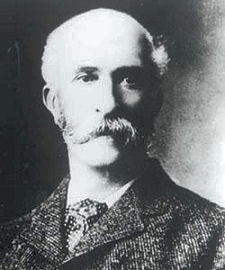 Thomas Blake Glover's Town of Birth, Fraserburgh |
Thomas Blake Glover lived from 6 June 1838 to 16 December 1911. Born in Fraserburgh he went on to become one of the first westerners to establish a business in Japan, today being widely remembered there as one of the founding fathers of modern Japan. The wider picture in Scotland at the time is set out in our Historical Timeline.
Glover was born at 15 Commerce Street, Fraserburgh, the fifth son in a family of seven boys and one girl. His mother was from Fordyce, and his father was Fraserburgh's Chief Coastguard, having previously served as an officer in the Royal Navy. In 1851 the family moved to Bridge of Don near Aberdeen.
After he left school, Glover took up employment with the trading company, Jardine, Matheson & Co. He first visited Japan in 1857, which at the time was widely viewed as a closed society where business was both difficult and dangerous for outsiders. In 1859 the 21 year old Glover established a presence for Jardine Matheson in Nagasaki, buying Japanese green tea. Two years later he set up his own company in Nagasaki, the Glover Trading Company (Guraba-Shokai).
The 1860s were a period of considerable success for Glover. He started by trading in ships and arms to a number of rebellious clans opposed to the established regime in Japan. In 1865 he introduced the first steam locomotive ever seen in Japan, the "Iron Duke", and by 1868 he was influential enough to play a part in the downfall of the Tokugawa Shogunate during the Meiji Restoration. This left him very favourably placed with the new regime, and in 1869 he commissioned one of the first modern warships to serve in the Imperial Japanese Navy, the Jho Sho Maru, later called the Ryujo Maru. This was built by Alexander Hall & Company in Aberdeen.
By the end of the 1860s Glover was also operating Japan's first coal mines and had built its first dry dock. He went bankrupt in 1870, but this proved only a temporary setback. He went on to found a shipbuilding company, which later became the Mitsubishi Corporation of Japan. He also helped set up the Japan Brewery Company, which went on to become the Kirin Brewery Company, now a major player in the Asian market. Some have suggested that the facial hair of the fantastic creature that appears on Kirin Beer labels is in memory of Glover and his own moustache. Glover became the first non-Japanese recipient of the prestigious Order the or Rising Sun.
In the 1870s Glover married Yamamura Tsuru, reputedly the former wife of a samurai warrior she had been obliged to divorce because of political differences between her family and his. They settled at Glover House in Nagasaki, the house Glover had built in 1863, and the oldest western-style building in Japan. Together they had a son and a daughter, though there have been suggestions that the son was actually by another Japanese woman, Kaga Maki, in circumstances that are unclear but possibly predated Glover's relationship with Yamamura Tsuru. In any event, Glover and Tsuru lived together until the latter's death in 1899. In 1911 Glover himself died in Tokyo, and was later buried at the Sakamoto International Cemetery in Nagasaki.
There is one further twist to the story of Thomas Blake Glover and Yamamura Tsuru. Many believe that she became the inspiration for Giacomo Puccini's opera "Madame Butterfly," which is set in Nagasaki. Others dispute this, but the Madam Butterfly link features prominently in exhibits on show at Glover House in Nagasaki, which is now a museum devoted to him. Meanwhile, the Glover family home at 79 Balgownie Road, Bridge of Don, has also become a museum about Thomas Blake Glover. 15 Commerce Street, Fraserburgh, fared less well, being destroyed by a bomb in WWII.

